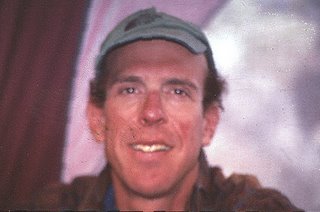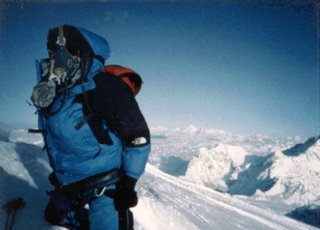This blog is devoted to Dan Mazur, a hero. Dan was nominated at www.heroesforhumanity.com. This blog is covering his current expedition and following this post are photos of his previous climbs up Mount Everest. This is his story.
On the morning of May 26th 2006, Dan Mazur was leading a team of climbers on a planned ascent up the north ridge of Mount Everest to its summit. Mr. Mazur’s team of climbers consisted of himself, Andrew Brash, Myles Osborne and Jangbu Sherpa. The team was feeling strong and healthy. There were no winds or clouds. Conditions seemed perfect for climbing to the summit. At 7:30 AM, eight hours into their ascent and two hours below the summit, the men encountered a stricken climber at an altitude of approximately 28,000 feet.
The fallen climber was an Australian named Lincoln Hall. He was sitting on the trail with his jacket around his waist, wearing no hat or gloves. The group stopped to investigate and found he was suffering from symptoms of edema, frostbite and dehydration. He was alone and hallucinating; and generally incoherent in his responses to their offers of help. He was without any of the proper equipment for survival in such conditions.
Apparently Mr. Hall had collapsed the previous day on his way down from the summit. The North Ridge is an inhospitable place. Besides being at 28,000 feet, it is located along a severe ridge line, dropping off 10,000 feet to one side and 7,000 feet to the other. Oxygen and proper equipment are virtually essential to survival. Mazur’s party quickly decided to give up their own summit attempt to save Mr. Hall. They anchored him to the mountain, replaced the hat, jacket and gloves he had discarded, and gave him their own oxygen, food and water.
They radioed Hall’s team, who had given him up for dead. Mazur convinced them that Hall was still alive and must and could be saved. (Mr. Hall’s team leader had called his wife the night before to tell her that Hall was dead). The rescuers arranged for Sherpas from Hall’s team to ascend and help with the rescue.
Mazur’s group stayed four hours to care for Mr. Hall. Phil Crampton coordinated the rescue from the high camp at 26,000ft and Kipa Sherpa acted as liaison to Lincoln Hall’s team at advance base camp at 21,000ft. Extended stays at extreme altitude are risky when planned in advance and when climbers have all the supplies they need. Going to the summit after so many hours spent helping Hall was out of the question.
By using their own survival supplies to sustain Hall, Mazur and his team risked worsening weather conditions that could have severely inhibited their own descent. Clearly, these men sacrificed a lifetime dream and risked their own lives to save Lincoln Hall. What is especially gripping about this story is that several days before the rescue another climber named David Sharp, who had collapsed a bit lower on the mountain than Mr. Hall, was passed by 40 climbers on their way to the summit, who did not stop to help him.
Mr. Sharp eventually died after 3 days, because he received no help. Faced with the same situation, Mazur and company decided to help.
In addition to being an expedition leader Mazur is also involved in starting hospitals and schools in poor parts of Nepal where 4000 people live cut off from any roads, electricity, phones or running water. He continues to be involved in raising money and managing those projects on a constant basis. Much more information is available at www.mounteverestfoundation.org




On the morning of May 26th 2006, Dan Mazur was leading a team of climbers on a planned ascent up the north ridge of Mount Everest to its summit. Mr. Mazur’s team of climbers consisted of himself, Andrew Brash, Myles Osborne and Jangbu Sherpa. The team was feeling strong and healthy. There were no winds or clouds. Conditions seemed perfect for climbing to the summit. At 7:30 AM, eight hours into their ascent and two hours below the summit, the men encountered a stricken climber at an altitude of approximately 28,000 feet.
The fallen climber was an Australian named Lincoln Hall. He was sitting on the trail with his jacket around his waist, wearing no hat or gloves. The group stopped to investigate and found he was suffering from symptoms of edema, frostbite and dehydration. He was alone and hallucinating; and generally incoherent in his responses to their offers of help. He was without any of the proper equipment for survival in such conditions.
Apparently Mr. Hall had collapsed the previous day on his way down from the summit. The North Ridge is an inhospitable place. Besides being at 28,000 feet, it is located along a severe ridge line, dropping off 10,000 feet to one side and 7,000 feet to the other. Oxygen and proper equipment are virtually essential to survival. Mazur’s party quickly decided to give up their own summit attempt to save Mr. Hall. They anchored him to the mountain, replaced the hat, jacket and gloves he had discarded, and gave him their own oxygen, food and water.
They radioed Hall’s team, who had given him up for dead. Mazur convinced them that Hall was still alive and must and could be saved. (Mr. Hall’s team leader had called his wife the night before to tell her that Hall was dead). The rescuers arranged for Sherpas from Hall’s team to ascend and help with the rescue.
Mazur’s group stayed four hours to care for Mr. Hall. Phil Crampton coordinated the rescue from the high camp at 26,000ft and Kipa Sherpa acted as liaison to Lincoln Hall’s team at advance base camp at 21,000ft. Extended stays at extreme altitude are risky when planned in advance and when climbers have all the supplies they need. Going to the summit after so many hours spent helping Hall was out of the question.
By using their own survival supplies to sustain Hall, Mazur and his team risked worsening weather conditions that could have severely inhibited their own descent. Clearly, these men sacrificed a lifetime dream and risked their own lives to save Lincoln Hall. What is especially gripping about this story is that several days before the rescue another climber named David Sharp, who had collapsed a bit lower on the mountain than Mr. Hall, was passed by 40 climbers on their way to the summit, who did not stop to help him.
Mr. Sharp eventually died after 3 days, because he received no help. Faced with the same situation, Mazur and company decided to help.
In addition to being an expedition leader Mazur is also involved in starting hospitals and schools in poor parts of Nepal where 4000 people live cut off from any roads, electricity, phones or running water. He continues to be involved in raising money and managing those projects on a constant basis. Much more information is available at www.mounteverestfoundation.org






0 Comments:
Post a Comment
<< Home